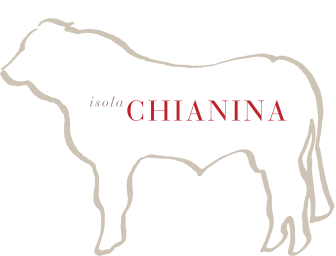Flavour
As food lovers invested in every aspect of the gastronomic journey, our goal is to produce beef that's been raised with great taste in mind.
We run two breeds of cattle: our wonderfully tasty Chianina, so highly valued in Italy; and a Chianina Black Angus cross, Chiangus.
But why is our beef so good? The key lies in a balance of factors: the breed; the farm; and the handling and ageing after slaughter.
The Breed: The genetic properties of an animal play a part in the quality and flavour of the meat that they yield. Every breed has its own unique characteristics and the Chianina have, for centuries been selectively bred for beef production.
The Farm: it is important to consider that bovine creatures are not naturally grain eaters. Allowing them to roam and graze freely, at their own pace, in beautiful diverse pastures plays an incredible part in the taste, texture, marbling and muscle – making for great eating. Low stocking rates, chemical free farming and conscious re-vegetation for soil health and animal shelter are just some of the important practices we employ.
Handling and Aging: Our animals are killed at a small, local, family-owned abattoir, by people who share our focus in treating these magnificent animals with utmost respect – both in the way they live and die. Following through with this approach, we eschew commercial practice, with its focus on maximal animal weight to maximise financial return - by following the time-honoured tradition of dry ageing. Much like the abandonment of tree-ripening and direct picking of fruit by modern farming practice – the elevation of commercial considerations above all else robs us of flavour. It may present as less cost efficient way of doing things, but the trade-off in favour of flavour intensity is incredible.
Gastronomy
Without a doubt the most famous dish in regards to the Chianina breed is La Bistecca Fiorentina. The Florentines consider it one of the highest expressions of Tuscan gastronomical achievement. It will however be a long and arduous debate over which cut is actually used. The Italians don't really care much for our "English" butchering styles and whether la Bistecca is a T-bone or a porterhouse or indeed a rib eye is of little consequence, and there is probably regional diversity in the cut of meat served by various restaurants.
The reality is that Italians are (and have been for millennia), the proponents of "Nose to Tail" eating, i.e. they don't waste anything. They would have traditionally used some form of steak as the Bistecca and then the various other "lesser" cuts would have been used in the multitude of delicious beef dishes that they excel at. Being such a rich tasting meat, some of our favourite dishes are those that involve long slow cooking methods as these bring out the divine unctuous flavours that short sharp cooking methods don't maximise.
We will be posting some of our favourite recipes soon, but in the meantime we have given you the traditional way to cook la Bistecca.

